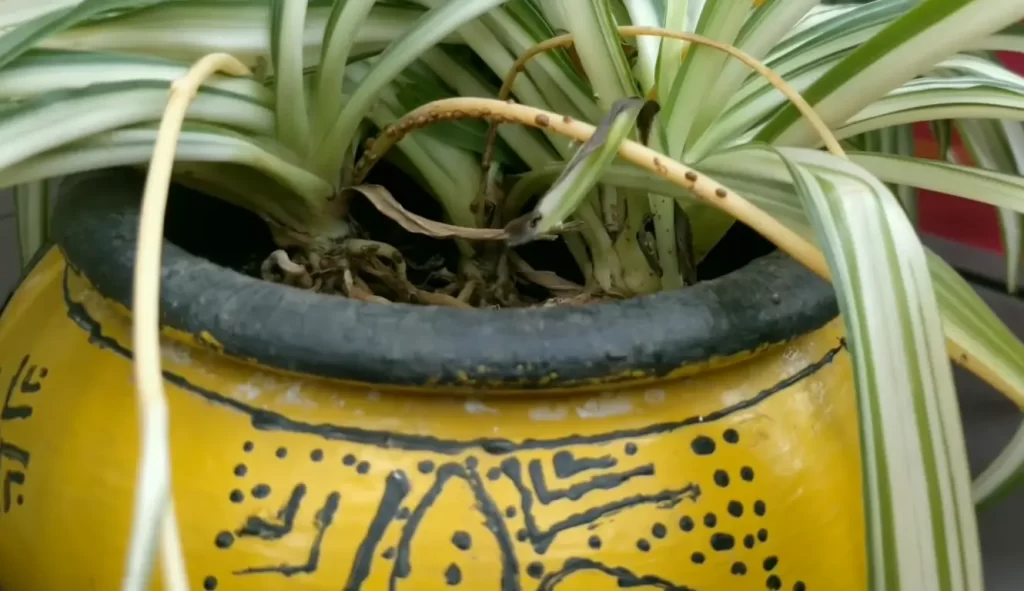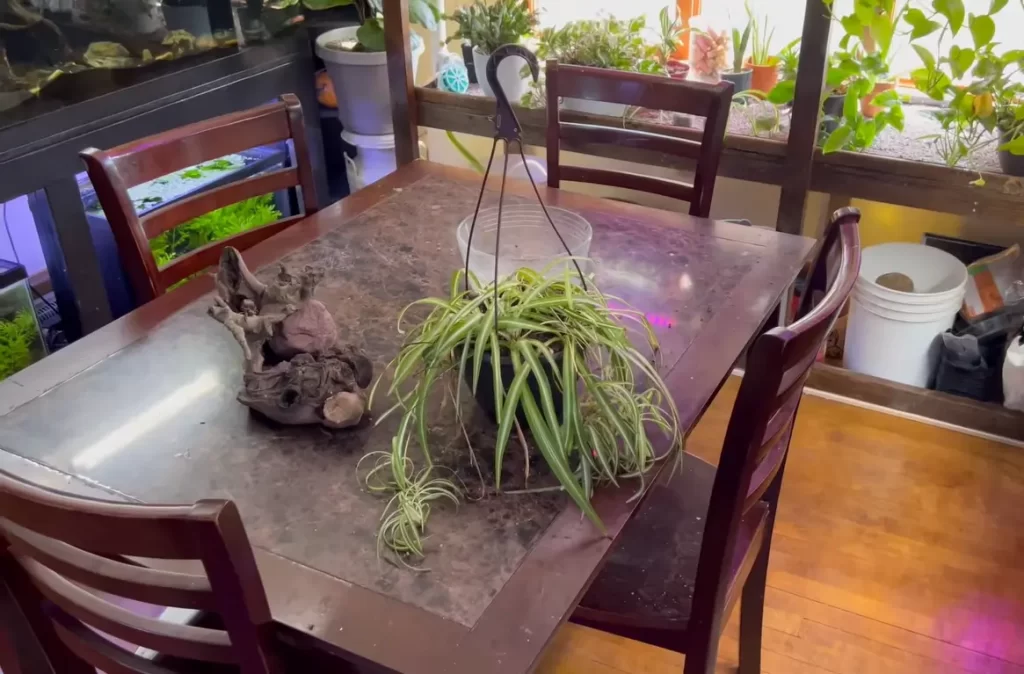How To Save A Dying Spider Plant: + Tips & Tricks
Spider plants are one of the most beloved houseplants for their air-purifying qualities, easy-to-care-for nature, and attractive appearance. However, even with proper care, these plants can struggle and seem to die.
It can be disheartening for plant enthusiasts to watch their spider plant wither away. If you’ve ever encountered such situations, you might be thinking about how to save a dying spider plant.
To save a dying spider plant, you’ll need to remove any dead or dying leaves and stems. Then, water the plant thoroughly and move it to an area with bright, indirect sunlight. Finally, fertilize the plant every two weeks with a balanced liquid fertilizer.
For your convenience, in this guide, we will explore the common reasons for a spider plant’s decline and provide actionable tips to save it.
Common Reasons For A Dying Spider Plant
Spider plants are popular indoor plants for their air-purifying ability and easy care. However, sometimes they can struggle and die, leaving their owners wondering what went wrong.

Here are some common reasons for a dying spider plant:
Soil Issues
The soil is crucial for plant health, and spider plants prefer well-draining soil that is not too dry or soggy. Using the wrong soil type or changing it frequently can lead to poor drainage, nutrient depletion, or root rot. Over time, the soil may also become compacted or infested with pests or diseases.
Light Conditions
Spider plants can tolerate various conditions but do best in bright, indirect light. Too much or too little light can affect their growth and cause stress. Direct sunlight can scorch their leaves, while low light can make them weak and leggy.
Watering Habits
Watering is another critical factor for spider plant survival. Although they are drought-tolerant, they still need regular watering to thrive. Conversely, overwatering can drown their roots and cause leaf yellowing, wilting, or fungus growth. Under watering can lead to dryness, leaf drop, or stunted growth.
Humidity Levels
Humidity is the amount of moisture in the air, and spider plants appreciate moderate to high humidity levels. Dry air can make their leaves brown and crispy, especially in winter or near heating or cooling sources.
Fertilization
Fertilization can enhance spider plant growth and foliage, but too much or too little fertilizer can harm them. Over fertilization can cause fertilizer burn, yellowing, or death, while under fertilization can lead to pale or small leaves.
Temperature and Airflow
Spider plants prefer moderate temperatures between 60 °F and 80 °F and good airflow. Extreme temperatures, drafts, or stagnant air can affect their growth and health.
How To Save A Dying Spider Plant
Like any living organism, spider plants can become sick and start to die. Here, we’ll provide tips on how to save a dying spider plant and nurse it back to health.
1. Identify the Signs of a Dying Spider Plant
Before saving a dying spider plant, you need to identify the signs of a sick plant. Some common signs include brown or discolored leaves, slow growth, stunted growth, and disfigured growth. Overwatered Spider plants may also suffer from root rot, which can cause the entire plant to die.
2. Adjust the Light and Temperature Conditions
Spider plants prefer bright, indirect light. Move your plant to a brighter spot if it is not getting enough light. Conversely, if the plant is exposed to too much direct sunlight, it can also become sick.
In this case, move the plant to a shadier spot. Additionally, spider plants prefer temperatures between 60 and 75 degrees Fahrenheit. If the temperature in your home is outside this range, consider moving the plant to a more suitable location.
3. Check the Soil Moisture and Drainage
Spider plants prefer well-draining soil that is kept moist but not soggy. If the soil is dry, give the plant a thorough watering. On the other hand, if the soil is too wet, reduce the amount of water you give the plant. Additionally, ensure the pot has adequate drainage holes to prevent excess water from sitting in the soil.
4. Adjust the Humidity and Fertilizer Levels
Spider plants prefer a slightly humid environment. If your home is dry, consider placing a tray of water near the plant to increase the humidity levels. Additionally, spider plants require regular fertilization to support healthy growth.
Use a water-soluble fertilizer once a month during the growing season, but avoid over-fertilizing, which can cause fertilizer burn.
5. Trim the Foliage and Remove Dead Leaves
If your spider plant suffers from brown or discolored leaves, trim them off to encourage healthy growth. Additionally, remove any dead leaves or foliage from the plant, which can attract pests and diseases.
6. Use Alcohol to Treat Pests
If your spider plant has pests like spider mites or mealy bugs, wipe the leaves with a cotton swab dipped in rubbing alcohol. This will kill the pests without harming the plant.
7. Repot the Plant
If your spider plant is severely sick, repotting it may be necessary. Use fresh soil and a pot slightly larger than the current pot. Ensure the new pot has ample drainage holes to prevent excess water from sitting in the soil.
Symptoms Of A Dying Spider Plant
Spider plants can still experience problems that could lead to their decline and death. So, you should be aware of the symptoms of a dying spider plant to be able to take the necessary actions and revive them.
- Foliage Discoloration: One of the most common signs of a dying spider plant is when its leaves turn brown or yellow. This could be due to factors such as overwatering, exposure to direct sunlight, or lack of proper nutrients.
- Slow or Stunted Growth: Spider plants are known for their rapid growth, but when they start to grow slowly or stop growing altogether, it could indicate a problem. This could be due to poor soil conditions, insufficient light, or inadequate watering.
- Root Rot: Spider plants are sensitive to excess water, and when the soil is constantly moist, it can lead to root rot. A foul odor, mushy roots, and yellowing leaves can identify this.
- Lack of New Growth: A healthy spider plant should regularly produce new shoots or plantlets. A lack of new growth could indicate that the plant is not receiving enough light, nutrients, or moisture.
- Drooping or Wilting Leaves: When spider plant leaves droop or wilt, it could be due to under-watering or poor drainage. It could also indicate a lack of humidity in the surrounding environment.
General Tips to Keep a Spider Plant Healthy
Spider plants, also known as Chlorophytum comosum, are popular indoor plants known for their easy maintenance and air-purifying capabilities.

To keep your spider plant healthy, consider the following tips:
- Soil: Spider plants prefer well-draining soil. Use fresh soil when repotting your plant, and ensure the soil is moist but not overly wet.
- Light: Spider plants do well in bright, indirect light but can also tolerate some direct sunlight. Avoid placing your plant in low light conditions, as it can lead to slow growth and foliage discoloration.
- Humidity: Spider plants prefer moderate to high humidity levels. Consider placing a tray of water near your plant or misting it occasionally to increase the moisture in the air.
- Fertilizer: Spider plants do not require frequent fertilization, but occasional feeding with a water-soluble fertilizer can promote healthy growth. Be careful not to over-fertilize, as this can cause fertilizer burn.
- Watering: Water your spider plant when the top inch of soil feels dry. So, avoid overhead watering, which can lead to foliar diseases.
Wrapping Up
You should now have a good idea of how to save a dying spider plant. Generally, the best way to save a dying spider plant is to ensure it receives enough light, water, and nutrients.
Additionally, you should regularly inspect the plant and remove any dead or damaged leaves. Pruning the plant is also recommended to maintain its shape and appearance.
Finally, be aware of the potential for pests or diseases and address these issues promptly with treatments as needed. A spider plant can be revived to its original thriving state with the right care and attention.
